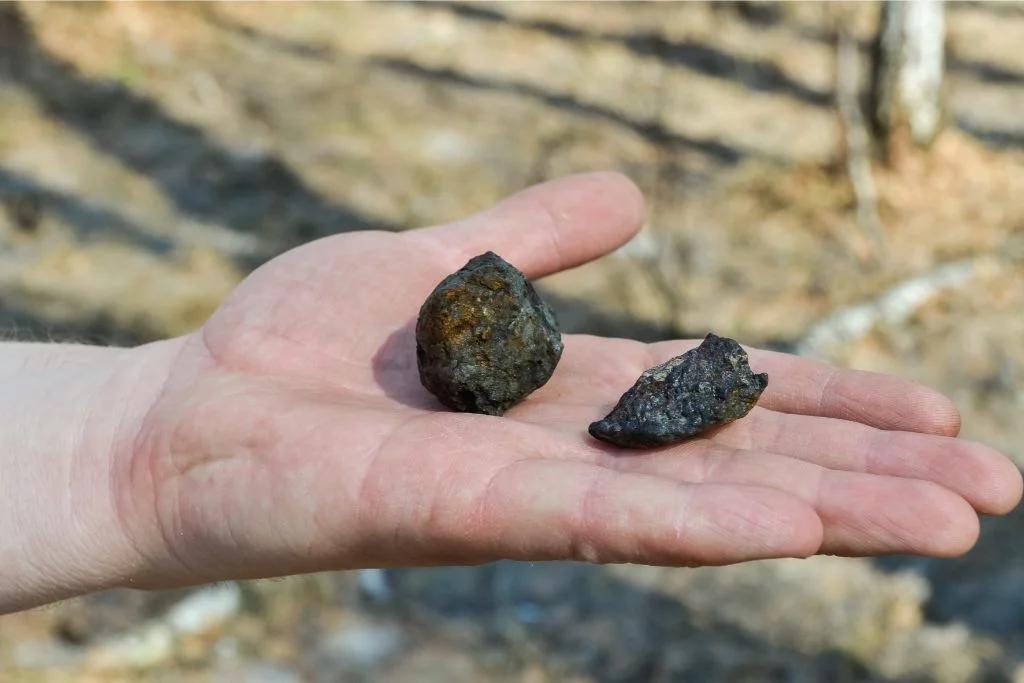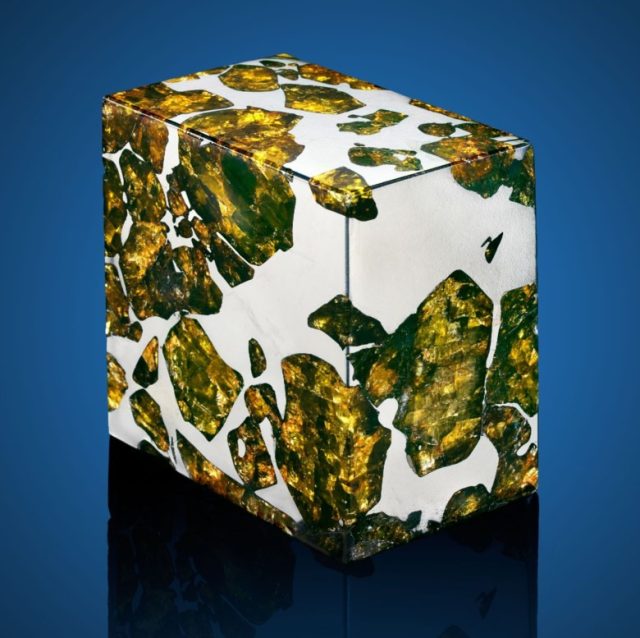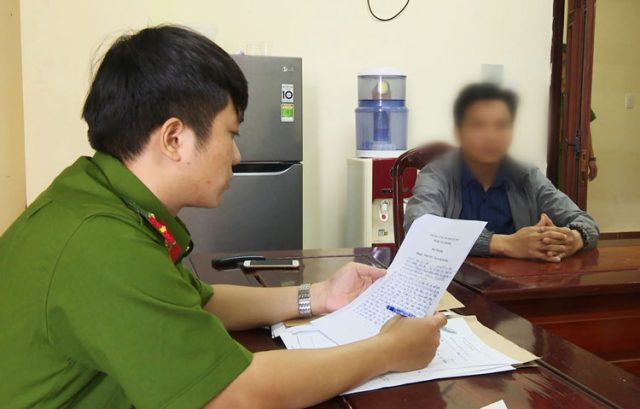
Concept
Meteor, in the Sino-Vietnamese sense of “sky stone”, is currently used inconsistently in Vietnamese, to refer to many types of celestial bodies with completely different natures.
A meteoroid is a natural object from outer space that impacts the Earth’s surface.
Additionally, rocky meteorites that have not been altered by melting or alteration of the parent meteorite source, are called chondrites
Meteorites are pieces of asteroids and other celestial bodies such as the moon and Mars that travel through space and fall to earth.
When a meteor enters Earth’s atmosphere, the fireball produces light due to friction between its surface and the air. A trail of smoke or dust created in the sky by a fireball caused by the removal of material from the surface of a meteorite
Number of meteorites found on Earth
More than 50,000 meteorites have been found on Earth
Of these, 99.8% come from asteroids. The remaining small fraction (0.2%) of meteorites is divided almost equally between meteorites from Mars and the Moon. More than 60 known Martian meteorites have been blasted off Mars by meteorite impacts. All are igneous rocks crystallized from magma. These rocks are very similar to Earth rocks with some special compositions that suggest a Martian origin.
Identify meteorites
– External identification characteristics:
+ If the stone is a newly fallen meteorite, it will be shiny black due to being burned while passing through the atmosphere. However, after a period of time on Earth, the iron in the meteorite will turn to rust and turn the stone brown.
+ Shape: meteorites are not round, they are often asymmetrical with different sizes and shapes. Although some meteorites are cone-shaped, most do not have an aerodynamic shape when they land. Despite their asymmetrical shape, most meteorites have rounded or sharp edges
+ Molten crust: The molten crust will usually be smooth and featureless, but can also be wavy and have “drops” as the molten rock accumulates and hardens, looking like a black eggshell cover the stone
+ Wavy lines on the surface: Wavy lines on the molten shell form when the shell is melted and pressed back. Wavy lines may be quite small or not clearly visible to the naked eye, as they may be broken or not completely straight. Use a magnifying glass and look closely for wavy lines on the stone’s surface
+ Depressions or depressions on the surface of the stone: Although the surface of a meteorite is usually featureless, it can also have depressions and deep grooves that look like thumb prints.
+ Although dents and grooves on the surface are indicative of meteorites, no meteorite has holes in its interior. Meteorites are solid rocks; If your stone is porous or has lots of foam, it is not a meteorite
– Physical properties of the stone
+ Heavy weight: Meteorites are solid rocks that often contain a lot of metal. You can calculate the density of that stone by dividing the weight by the volume. If the density is greater than 3 units, it is likely to be a meteorite
+ Adjective: Almost all meteorites are more or less magnetic. That’s because meteorites have high levels of iron and nickel, which are magnetic metals. Iron meteorites are more magnetic than stone meteorites and are often strong enough to affect compasses when placed close to them.
+ Rub the stone on unglazed porcelain: This test is a fairly accurate way to rule out materials originating from the earth. Rub the stone on the unglazed surface of the porcelain tile; If it leaves a light gray streak, it’s a meteorite…
Classify
There are three main groups of meteorites. They differ in the amount of iron-nickel metal and what they reveal about the early solar system.
There are three main types of meteorites:
• Iron meteorite : almost entirely made of metal
• Iron meteorites: have roughly equal amounts of metal crystals and silicates
• stony meteorites: mainly contain silicate minerals
+ Iron meteorites: Most iron meteorites are thought to be the cores of asteroids that melted early in their history. They are mainly composed of iron-nickel metal with small amounts of sulfide and carbide minerals.
+ Stone meteorites: mainly contain silicate minerals
There are two main types of stony meteorites: chondrites (some of the oldest materials in the solar system) and achondrites (including meteorites from asteroids, Mars, and the moon).
+ Stone-iron meteorites: Stone-iron meteorites consist of almost equal parts of iron-nickel and silicate metallic minerals, including both precious and semi-precious gems. They are considered some of the most beautiful meteorites. There are two different types of iron-stone meteorites: pallasite and mesosiderite.
Are meteorites radioactive?
Meteorites contain radioactive elements, but not significantly more than any common terrestrial rock.
Determine ownership
– Argentina
Most Argentine provinces apply civil code principles to ownership of property, which in most cases belongs to the landowner. The Constitution of the Province of Chaco may be the only constitution in the world that declares the meteorites as the property of the province and imposes an obligation to protect them (Constitution of the Province of Chaco, section 10),
– Australia:
Some state laws regulate ownership in state museums, prohibit prospecting except for transfer back to the museum, and permit reimbursement of finder’s expenses
– Canada:
In most cases, Meteors are the property of the landowner and can be sold without reporting except in the case of meteorites exported by Canadians. Under the Cultural Property Import and Export Act, Canadian goods cannot be exported without a license from the Federal Council. This may impose a permanent export delay of six months, during which time an entity in Canada can purchase it at a reasonable price, if the export is not authorized. A temporary export license was issued shortly thereafter.
– Czech Republic
There is no specific law or decisive case, but under the post-socialist system, museums operate on the basis of land ownership including ownership of assets on land and payments are made by museum. Even during the period of socialist legislation, finders were paid by museums to deliver meteorites.
– Denmark:
According to s.36b of the Museums Act (1989), the find is a “geological object of unique scientific value” and must be handed over to a state museum. Under s.36b(3) the museum pays the finder a fee based on market value adjusted for the finder’s speed and care in discharging this duty. Greenland, as part of Denmark, has a similar rule, so Danish meteorite law would become more important if a meteorite stranding site were found there (Harvey et al., 2001).
– India:
Resolution of the Government of India, Department of Revenue & Agriculture, No. 45G-22-13, dated 28 April 1885, at Simla, providing that “all aerolite falls together with the papers relating thereto should in the first place be forwarded to the Government Geological Museum, Calcutta”. By circular letters (no. 14870-14883-119 of 1914 of 19 December and no. M-1184 of 1925 of 9 June) addressed to all local authorities, the national government requested compliance with the resolution . The museum is under the control of the Director of the Geological Survey of India. No compensation is paid to finders and possession of a new find is usually made by representatives of the Geological Survey of India or local police.
– Japan:
The finder is the owner, according to article 239 of the Minpou (Japanese civil code), which stipulates that an object found without a previous owner is the property of the first person to claim ownership.
– New Zealand
Under the New Zealand Antiquities Act (1975, No. 41, consolidated 1990), Section 2(f), a meteorite is classified as an antiquity, and therefore, cannot be exported without a government permit. government (Section 5). Section 11 stipulates that the person who finds the meteorite must notify certain government officials. Meteorite sales in New Zealand are limited to registered collectors or licensed second-hand dealers.
– Switzerland:
Swiss Civil Code (Schweizerisches Zivilgesetzbuch (Swiss Auflage 1986)) Article 724 states that discovered Meteorites belong to the canton (state), but the finder is paid compensation no higher than the value of the meteorite. object.
– The United States of America:
Meteorites discovered are owned by the landowner; if discovered on federal government property, they are owned by the Department of the Interior but may be acquired by the Smithsonian Institution.
– Vietnam
There are no regulations on owning meteorites
Conclude:
Meteorite ownership laws vary from country to country, but in most places, the landowner of the find is considered the owner of the meteorite. Recent legislation in many countries has moved towards mandatory surrender to the state, with compensation paid to the finder.
The value of meteorites
Meteorites can be very valuable to scientists who study planetary science and to collectors. Individual stones can weigh just a few grams or hundreds of kilograms. Their value varies widely based on rarity and composition, as well as the conditions in which they are found.
Ungraded chondrite stones picked up by nomads wandering the Sahara desert are available for about $0.50 per gram. Attractive stones from the fall witnessed by Gao-Guenie (Burkina Faso, Africa, March 5, 1960) can be purchased for around $1.50/gram and a top quality specimen weighs one kilogram of the Campo del Cielo iron meteorite from Chaco Province, Argentina can be yours for around $400.
– Russian Sikhote-Alin Iron (dropped February 12, 1947): A high-grade Sikhote-Alin specimen will cost $2 to $3/gram.
– Pallasites are iron meteorites containing olivine (gemstone peridot): Prepared pallasite slices such as Imilac (Chile), Glorieta Mountain (New Mexico, USA) and Esquel (Argentina) are prized for their gemstone of many colors and long-term stability, and will cost between $20 and $40/gram
– An elemental specimen will easily fetch $50/gram while rare examples of Lunar and Martian meteorites can sell for $1,000/gram or more – nearly forty times the price of gold Present
Meteorite specimens
– Fukang meteorite – profile of the most beautiful extraterrestrial substance known, Pallasite-PAL, Fukang, Xinjiang Uyghur Autonomous Region. 64 x 64 x 42 mm (2.5 x 2.5 x 1.66 in). Estimate: $25,000-35,000.

– A giant rocky meteorite – NWA 8413, H6 Sahara Desert. 60 x 50 x 43 cm (24 x 21 x17 in). Sold for £74,500 on 20 April 2016 at Christie’s in London, South Kensington

– Personal oriented Murchison, CM2 Victoria, Australia. 58 x 40 x 25 mm (2¼ x 1½ x 1 in). Sold for £23,750 on 20 April 2016 at Christie’s in London, South Kensington

– Part of the Gibeon meteorite with natural holes, iron, octahedral rocks, Gibeon, Great Nama Land, Namibia. 81 x 49 x 4 mm (3 x 2 x 0.1 in). Estimate: $1,200-1,800

– Gibeon meteorite – strange natural sculpture from outer space, iron, exquisite octagonal stone, Gibeon, Great Nama Land, Namibia. Estimate: 250,000-350,000 USD

– A large complete fragment of the imilac meteorite with extraterrestrial, iron peridot. Pallasite (Pal). Atacama Desert. 237 x 203 x 2 mm (9⅓ x 8 x⅛ in). Sold for £20,000 on 20 April 2016 at Christie’s in London, South Kensington

– A fragment of Jepara pallasite, iron and stone. Pallasite (Pal) Java, Indonesia . 58 x 37 x 37 mm (2¼ x 1½ x 1½ in). Sold for $10,625 on May 10, 2017

– A triangular specimen of the Moon’s end piece showing the interior and exterior of a meteorite from the lunar meteorite clan NWA 8046, lunar feldspar, Sahara Desert, Mauritania. Estimate: 50,000-75,000 USD. Offered in The Moon and Beyond: Meteorites from Stifler Collection, July 11-19, 2019

Encyclopedia of meteorites
Vietnam has 3 falling meteorites, names:
+ Phu Hong, fallen 1887, weight 500g, location: Binh Thuan
+ Phuoc – Binh, fell in 1941, mass 11kg, location: Quang Nam – Da Nang
+ Tuan Tuc, fell in 1921, mass 13.1 kg, location: Can Tho
Meteors in Vietnam
Mr. Vinh still regrets the occasion when he almost took a meteorite as small as his finger, but when he put it on the scale, it weighed 4.5 kg. It appeared right in Hanoi, owned by a father and son from Nam Dinh. When he heard the news and arrived, the father and son took the precious meteorite and left because they were surrounded by gangsters and asked them to sell the meteorite for 10 billion VND.
Geologist Vinh “Scar” shared: “In Vietnam, there are at least 3 large lakes formed by meteorite impacts. These are Ba Be Lake in Bac Kan, Lak Lake in Buon Ma Thuot and “Bien Ho” in Pleiku (Gia Lai).
Currently, there are quite a few meteorite specimens on display at the Vietnam Geological Museum. According to this institute’s documents, the 38 precious meteorites preserved and displayed at the Vietnam Geological Museum are meteorites collected by the French in Vietnam and left behind after leaving Indochina.
Of those 38 pieces of meteorite, 35 pieces are displayed in Hanoi, 3 pieces are displayed at the Southern Institute (HCMC). Specifically, 3 pieces on display in Ho Chi Minh City include piece number 15/38, picked up by the French on July 18, 1941 in Thuc Binh, Hoi An, Quang Nam; piece number 16/38, picked up by the French on June 30, 1921, in Vinh Luoc, Rach Gia, Kien Giang; Piece number 17/38, picked up by the French in 1921, in Tuan Tuc, Soc Trang.
Determine ownership of meteorites according to Vietnamese law
• Civil Code 2015
Article 228. Establishing ownership of ownerless property and property whose owner cannot be identified
1. Derelict property is property whose owner has given up ownership rights to that property.
The person who discovered or is managing the ownerless movable property has the right to own that property, unless otherwise prescribed by law; If the property is real estate, it belongs to the State.
>>> Thus, the person who discovers or manages the derelict property, which is movable property, has ownership rights to that property.
• Civil Code 2015
Article 229. Establishing ownership of buried, hidden, buried or sunken property found
2. Buried, hidden, buried or sunken property that is found without or whose owner cannot be determined, after deducting search and preservation costs, will have ownership rights to the property. This is defined as follows:
a) Property found to be a historical-cultural relic according to the provisions of the Cultural Heritage Law belongs to the State; The person who finds that property is entitled to a reward according to the provisions of law;
b) Property found that is not property belonging to historical – cultural relics according to the provisions of the Cultural Heritage Law but has a value less than or equal to ten times the base salary prescribed by the State shall be possession of the finder; If the property found has a value greater than ten times the base salary prescribed by the State, the finder will receive a value equal to ten times the base salary prescribed by the State and 50% of the value of the excess. ten times the base salary prescribed by the State, the remaining value belongs to the State.
• Cultural Heritage Law 2013
Article 4.
2. Tangible cultural heritage is material products with historical, cultural, and scientific value, including historical-cultural relics, scenic spots, relics, antiques, and national treasures .
Article 6.
All cultural heritage underground on the mainland, islands, internal waters, territorial sea, exclusive economic zone and continental shelf of the Socialist Republic of Vietnam are state-owned.
The 7th rule.
Cultural heritage discovered without an identifiable owner, obtained during archaeological exploration and excavation, is state-owned.
>> In case a meteorite is a relic or antique, it belongs to the State and the finder is entitled to a bonus according to the provisions of law.
>>In case the meteorite is not a historical-cultural relic but has a value less than or equal to ten times the base salary prescribed by the State, it belongs to the finder.
>>In case the meteorite is not a historical-cultural relic but has a value greater than ten times the base salary prescribed by the State, the finder will receive a value equal to ten times the base salary prescribed by the State. regulations and 50% of the value of the portion exceeding ten times the base salary prescribed by the State, the remaining value belongs to the State.
>> However, the case where this regulation applies is that the object must be found buried, hidden, buried, or sunk.
II. Actual cases of fraud in Vietnam
Case 1
On December 22, news from the Tra Vinh Provincial Police Department announced that they had prosecuted the defendant and temporarily detained Kim Anh (53 years old, residing in Phuoc Hung commune, Tra Cu district) to investigate the act of “Fraudulent appropriation of goods”. take property”.
According to the initial investigation, in 2012, Mr. Thach Khone asked Mr. Thach Ngoc Tra (who lives in Tra Vinh province) to buy black copper (also known as meteorite) and promised to give Mr. Tra a commission.

Subject Kim Anh. CA photo.
In 2014, through someone else’s introduction, Mr. Tra went to Kim Anh’s house to ask to buy a meteorite. At this time, Kim Anh showed Mr. Tra a video recording a black metal object contained inside a plastic jar. This object is in the water and can move up and down.
Thinking it was a real meteorite, Mr. Tra reported it to Mr. Khone. After that, Mr. Khone contacted a person living in Ho Chi Minh City. Through Mr. Khone’s description, this man thought the object was a meteorite, so he asked Mr. Tra to approach him to buy it.
Afterwards, Mr. Tra asked Kim Anh to show him the real meteorite but was not accepted. Kim Anh said the meteorite is buried at home and cannot be retrieved yet. If you want to see it, Mr. Tra or the person who wants to buy it must regularly come to the house to pay their respects.
By 2015, Kim Anh signed a contract to sell the meteorite to Mr. Tra for nearly 2 billion VND. Mr. Tra transferred money to Kim Anh many times with a total amount of more than 1 billion VND. Then, because he ran out of money, Mr. Tra told Mr. Khone to continue giving him more money.
When Mr. Khone asked Kim Anh to deliver the goods, this person said the storage place was not safe. Kim Anh forced Mr. Khone to buy a house for him to live with his family and as a place to store meteorites. After getting the house, Kim Anh signed a contract to sell the meteorite to Mr. Khone for 800 million USD/kg.
At this time, Mr. Khone mobilized more than 10 billion VND to give to Kim Anh but did not record a specific receipt. After that, Kim Anh continued to sign a contract to sell 25.5kg of meteorites to a business in Dak Dak province, for 1.2 billion USD. Kim Anh received 600 million VND in advance.
When the company representative asked to check the meteorite, Kim Anh gave a plastic jar containing a black solution, inside there were 14 stones (construction stones) and said that it was a meteorite. The company discovered that the goods were fake and asked for a refund.
Kim Anh then continued to sign a contract to transfer the meteorite to another business in Ho Chi Minh City for 1.8 billion USD/kg. Total contract value is 45 billion USD.
However, before this transaction could be completed, Kim Anh’s actions were discovered and arrested by the investigation agency.
According to: https://tienphong.vn/ban-thien-thach-dom-lua-dao-hon-10-ty-dong-post1299689.tpo
Case 2:
Previously, on July 23, 2020, the Police Department of Lam Dong Province received a petition from Mr. Tuan accusing a group of people in Don Duong district of defrauding him of 280 million VND through meteorite trading transactions. Receiving the application and determining that the incident was true, the CSHS Department assigned officers to handle the investigation. Following the information from Mr. Tuan’s complaint, on August 8, the Police Department summoned three suspects, Ma Dien (49 years old), Ma Lin (54 years old) and Ma Len (29 years old, Ma Lin’s daughter). ), residing in R’Lom village (Tu Tra commune, Don Duong district) came to the office to work. Here, knowing that they could not hide the incident, all three suspects admitted to all acts of fraud.

Victim Mai Sy Tuan presented the incident to the police
Around the beginning of 2019, Ma Dien met Ma Len to discuss pretending to have meteorites to sell to scam victims of money. They assigned each other, Ma Dien looked for customers and introduced them to Ma Len. As someone who owns and needs to sell a meteorite, Ma Len goes to the internet to learn about the uses and features of meteorites to trick “prey”.
In February 2020, knowing that Mr. Vo Van Duoc (28 years old, residing in Phung Xa commune, My Duc district, Hanoi city) was looking to buy meteorites, Ma Dien immediately introduced Mr. Duoc to meet Ma Len. Hearing Ma Len introduce that he owns a 2.7kg meteorite stone that has the ability to break glass and freeze mercury when placed next to it and float on water, Mr. Duoc immediately believed it. They asked Mr. Duoc to give 3,000,000 VND to worship the stone and set a trial date 1 week later.

3 suspects Ma Len, Ma Dien and Ma Lin
At the appointment, Ma Len prepared beef fat in a plastic box and put black tape in her backpack with Ma Lin and Ma Dien to a village of the K’Ho ethnic group. Here, Ma Len asked a man in the village to pretend to be Ma Len’s biological uncle and paid him 100,000 VND. At the back of this house, Ma Len took the prepared plastic box and placed it on the ground and told Mr. Duoc to give her the piece of mirror that Duoc had prepared in advance. Mr. Duoc did not agree and offered to try it himself, but Ma Len did not agree, so the test was canceled. Thinking that Mr. Duoc did not believe her, Ma Len immediately invited Mr. Duoc to her home in R’Lom village to build trust. A few days later, Mr. Duoc called to meet Ma Len at a coffee shop in Lien Nghia town, Duc Trong district. Here, through Mr. Duoc’s introduction, Ma Len met and knew that Mr. Tuan was Mr. Duoc’s business partner. They also boasted, “There is another meteorite weighing about 3kg stored in the forest.” Hearing that, Mr. Duoc and Tuan agreed to buy both meteorites for 900 billion VND and the two sides planned to carry out the sale on May 18, 2020. Mr. Duoc authorized security Tuan has full authority to carry out this transaction.
The fraud group also invited Mr. Tuan home and introduced him to many relatives to build trust. Ma Len asked Mr. Tuan to advance 70,000,000 VND and Ma Len gave the family’s household registration book and Ma Len’s ID card for Mr. Tuan to keep as a deposit. The goods have not been tested yet, so we don’t know the true condition of the stone, but since then Ma Len has asked Mr. Tuan many times to add a deposit. Mr. Tuan transferred to Ma Len 10 times with a total deposit of 280 million VND. Having money, Ma Len gave her mother Ma Lin about 30 million VND, gave Ma Dien 5 million VND, and used the rest to pay off debt and spend it all.
About a month later, when it was time to negotiate a transaction to buy and sell meteorite stones, Mr. Tuan contacted him but Ma Len gave many reasons to beg. The following days, they did not answer the phone when Mr. Tuan called. Knowing that he had encountered scammers, Mr. Tuan filed a report to report the incident to the CSHS Department.
CASE 3:
Currently, in some provinces and cities (Can Tho, An Giang, Binh Thuan, Dong Nai, Lam Dong, Kon Tum…) there are many criminal gangs that fraudulently appropriate property by buying and selling. stone meteorites. This is one of the new and sophisticated tricks of fraud criminals, causing significant damage to the victim’s property and seriously affecting local security and order. National statistics show that since 2009, 37 cases of fraud with the above form have been discovered, of which the Police Department at all levels has prosecuted 22 cases and 62 defendants.
According to the investigation, the scammers used their tricks by having their accomplices pretend to be customers who wanted to buy Meteorite stones (also known as black copper, Uranium…) for tens of millions of USD per kilogram. At the same time, they send others to lure the victim to know where to sell cheap Meteorite stones in order to entice the victim to spend money and cooperate to buy Meteorite stones for resale. Because they were eager to make big profits and were told by the subjects about the “boundless” effects of Meteorite stones, the victims quickly joined in. After that, the perpetrators also created a scenario for the person playing the role of possessing the gems. To make the victim believe, the fraud group used a flint and a lighter spring near what was believed to be a meteorite for 10 minutes, then suddenly it crumbled into pieces. In addition, the fact that mercury placed near the “sky stone” also quickly clumped, so the victim trusted it completely and agreed to buy and sell it for tens of billions of dong. After receiving the deposit, they immediately appropriated it and fled.

